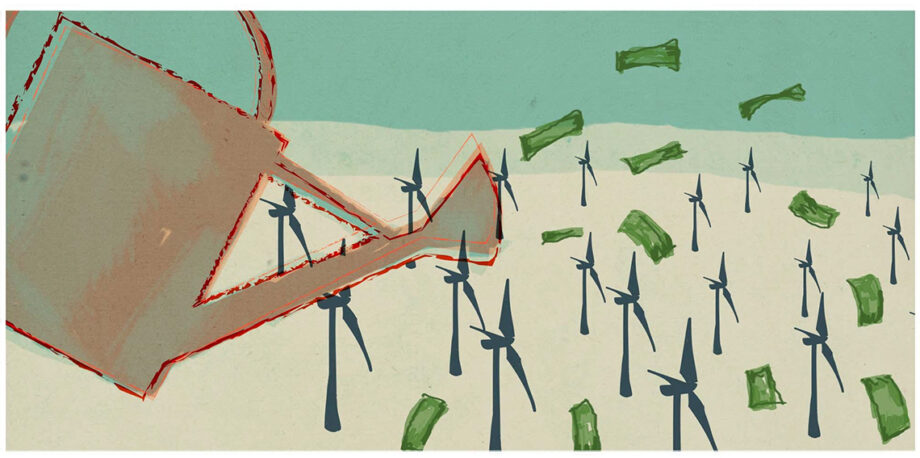November 11, 2015 — Institutional investors like to call themselves global investors, but when it comes to global clean energy financing that’s hardly the case. Pension funds, insurance companies and other investors manage trillions of dollars, but precious few of those dollars are being invested in renewable energy projects in developing countries — a key linchpin in curbing carbon pollution to avoid catastrophic global warming.
This investment gap needs to be closed. The conditions are ripe for doing so now as developing countries step to the plate with climate commitments in advance of the COP 21 international climate talks in Paris in early December.
The urgency in countries like Brazil, Kenya and India is obvious. Carbon pollution is still increasing, and the biggest reason is proliferating pollution in fast-growing Asia, South America and Africa. Barring major changes, energy-related pollution from developing countries will be more than double that from developed countries by 2040, according to the U.S. Energy Information Administration.
For investors, profits on investments are key, of course. But healthy investment portfolios also rely on a stable long-term global economy. And a rapidly warming planet jeopardizes economic stability. A 2014 study commissioned by Risky Business, a group that includes former Wall Street icons Hank Paulson and Robert Rubin, warns of billions of dollars in additional coastal damages every year in the U.S. due to higher sea levels and stronger storm surges. It also forecasts reduced crop yields of up to 70 percent in the Midwest and Southeast due to increased drought and flooding. And the U.S. is getting off easy. A recent study by Stanford University and the University of California, Berkeley, says that the worst effects of climate change will be seen in Africa, Asia, South America and the Middle East, and that overall, warming temperatures could reduce average global incomes roughly 23 percent by 2100 compared with a world without climate change.
“What climate change is doing is basically devaluing all the real estate south of the United States and making the whole planet less productive,” study co-author Solomon Hsiang, an economist and public policy professor at the University of California, Berkeley, told the Associated Press.
The good news on the investment front is that renewable energy is gaining traction in Africa and other emerging economies. Fueled by cheaper technology, renewable energy investments in developing countries in 2014 grew 10 times faster than equivalent investments in developed countries. Last year’s investments totaled US$131 billion, up 36 percent from 2013. Global investments totaled US$270 billion, well short of the additional $US1 trillion per year of clean energy investment that energy experts say is needed to avoid potentially catastrophic global warming.
![In 2014, investments in renewable energy in the developing world almost equaled those in the developed world, but more is needed. Image from Bloomberg New Energy Finance: UNEP. [Click to enlarge]](https://ensia.com/wp-content/uploads/2015/11/voices_energy_investment_1small.jpg)
In 2014, investments in renewable energy in the developing world almost equaled those in the developed world, but more is needed. Image from Bloomberg New Energy Finance: UNEP. [Click to enlarge]
To be sure, these commitments are aspirational, and it remains to be seen if the upcoming climate negotiations will make them more binding. Still, market signals are getting stronger, and all investors should be opening their eyes to this growing opportunity.
Global companies and financial firms are already dipping their toes. Bank of America made US$12 billion in low-carbon investments last year, including US$200 million in green bonds that helped finance two wind farms in Peru with a capacity of 114 megawatts. Last month, Google announced major financial backing for a 310-megawatt wind farm in northern Kenya, which will be Africa’s largest when it opens in 2017.
“The fastest growing economies are here [in Africa], and there’s a strong need for critical power,” Google director of energy and sustainability Rick Needham told Wired.
A small number of institutional investors are venturing into the space, including PensionDanmark and the California State Teachers’ Retirement System, but they are largely the exception. An analysis of institutional investor portfolios in 2013 — with collective assets totaling more than US$92 trillion — showed that only 0.3 percent was invested in sustainable energy infrastructure. And according to a 2015 Organisation for Economic Co-operation and Development report, virtually all of that capital was focused in developed countries.
![Most capital flows to sustainable energy infrastructure in developed countries. Image from Bloomberg New Energy Finance: UNEP. [Click to enlarge]](https://ensia.com/wp-content/uploads/2015/11/voices_energy_investment_2small.jpg)
Most capital flows to sustainable energy infrastructure in developed countries. Image from Bloomberg New Energy Finance: UNEP. [Click to enlarge]
Governments and policy-makers are working hard to eliminate investor roadblocks, such as policy and regulatory barriers, political uncertainties, and financing impediments. The World Bank is organizing trips through which representatives from Africa, South America and Asia can see firsthand how Denmark is integrating renewable energy into its electric grid. The Obama administration’s Power Africa program is mobilizing numerous U.S. agencies to help projects get developed, accelerate private financing and provide credit enhancements where needed. In just two years, the program has attracted more than US$20 billion in private financing for projects that will generate more than 4,100 megawatts of clean power.
Investors are also being emboldened by national successes such as South Africa’s landmark Independent Power Producers Procurement Program, which has approved 92 projects to date by big-name developers such as SunEdison and Abengoa Solar. The combination of attractive returns and a well-structured program makes South Africa “one of the most important centres for clean energy investment [globally],” clean energy analyst Luke Mills at Bloomberg New Energy Finance concluded in April.
Encouraging progress, to be sure, but global clean energy financing still remains mired by parochialism — a fact that U.S. Secretary of State John Kerry noted when he told a clean energy forum last month, “Ninety percent of private climate finance is invested into projects in the same country from which the money originated.”
The bottom line: Investors need to become truly global investors when it comes to solving climate change, and one of the best ways to do that is to invest in clean-energy infrastructure and production in developing countries where it’s already underway — just not at the level it needs to be. Until that happens, the economic toll of a warming planet on their portfolios will only worsen. ![]()
Editor’s note: The views expressed here are those of the author and not necessarily of Ensia. We present them to further discussion around important topics. We encourage you to respond with a comment below, following our commenting guidelines, which can be found here. In addition, you might consider submitting a Voices piece of your own. See Ensia’s “Contact” page for submission guidelines.
Ensia shares solutions-focused stories free of charge through our online magazine and partner media. That means audiences around the world have ready access to stories that can — and do — help them shape a better future. If you value our work, please show your support today.
Yes, I'll support Ensia!
